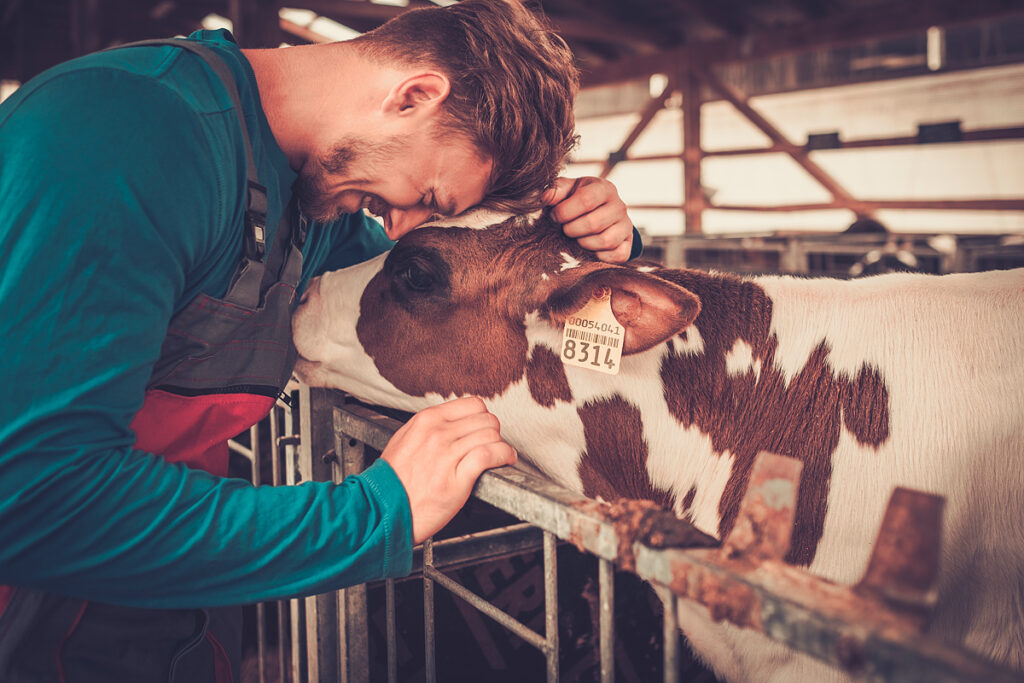Foot-and-mouth disease in artiodactyls
Foot-and-mouth disease (FMD) is a very contagious viral disease of artiodactyls, both wild and agricultural. FMD affects cattle, pigs, sheep, and goats. In young individuals, the disease leads to myocarditis and death.
The disease has a short incubation period: in pigs – from 1 to 3 days, in cattle – 3-4 days. The infection can spread quickly, so the average incidence in populations with an infected animal is about 100%.
Foot-and-mouth disease outbreaks lead to losses on a national scale. For example, in 2001, millions of animals were slaughtered in the Netherlands and the UK to prevent an epidemic. For the same reason, if there is an outbreak of the FMD in a country, the World Organization for Animal Health restricts tradings in FMD-susceptible animals and derived products in that country. In countries where food and farm animals are essential for subsistence agriculture, foot-and-mouth disease outbreaks seriously impact food security.
The high incidence, the complex species composition of the infected animals and the vast genetic diversity of the virus make the fight against foot-and-mouth disease a challenging task. The high genetic variability of the virus manifests itself in seven separate serotypes that do not provide cross-immune protection: a previous infection with one serotype does not protect six others.
To localize and eliminate outbreaks of foot-and-mouth disease, the movement of susceptible animals is restricted, infected and exposed animals are slaughtered, premises are disinfected, and vaccinations are carried out. Regular vaccination is carried out in endemic areas for foot-and-mouth disease: Africa, Asia, and South America. However, in countries recognized as free of the virus, vaccination is carried out only during disease outbreaks.
One of the main obstacles in the fight against the disease is the time to formate the immunity induced by the vaccine. It takes approximately 7 days. The foot and mouth disease virus multiplies much faster. It only takes 3-4 hours to start replicating in an infected cell. Therefore, scientists are looking for fast-acting antiviral agents to enhance the immunity of animals and suppress the multiplication of the virus to complement vaccination protocols.
The use of interferon is a promising approach to the complete protection of livestock from the foot-and-mouth disease virus
Scientists from the Center for the Study of Animal Diseases (USA) have been developing tools to eradicate the disease for more than 20 years. In 2018, researchers published a review of the accumulated scientific knowledge about how the foot-and-mouth disease virus counteracts innate immunity and suppresses a critical element of animal antiviral protection – the interferon system. It is the effective counteraction to the work of interferons that provides the virus with a window of opportunity for rapid replication. Therefore, scientists have focused their long-term efforts on developing tools that support the operation of the interferon system (IFN).
In 2001, this group of scientists in a series of laboratory experiments showed that porcine and bovine interferons type I (IFN-I) effectively suppress FMD virus replication. Scientists treated kidney cell cultures of pigs and cattle with interferon and then infected the cells with the foot-and-mouth disease virus. In the IFN-treated cells, the number of viral proteins did not increase even 4 hours after treatment.
In 2003, in a clinical trial on Yorkshire pigs, American researchers studied effective ways to deliver interferon to the body’s cells. The scientists used the non-reproducible human adenovirus as a transport for IFN-I. Intramuscular injections increased the production of their interferon in animals after 16 hours, and induced antiviral activity was observed for 3-5 days. 24 hours after the injections, the scientists infected pigs with the foot-and-mouth disease virus. The animals did not develop the disease, and they did not produce antibodies. The scientists concluded that this method of delivering porcine IFN allows the innate immune system to cope with the virus without adaptive immunity independently. Several subsequent studies by this group of scientists have shown that IFN-I delivered by human adenovirus is effective against all serotypes of the FMD virus.
In 2014, scientists evaluated porcine interferon type III (IFN-III) effectiveness against the foot-and-mouth disease virus. Type III interferons are produced primarily in the epithelium but involve the exact antiviral mechanisms as IFN-I. To deliver IFN-III to cells, as in the previous case, the scientists used human adenovirus. First, the pigs were injected with interferon, then vaccinated against the foot-and-mouth disease and infected with the virus. As a result, it was found that such therapy protected the animals from the disease in a dose-dependent manner. 7 out of 10 pigs did not develop the disease. In the remaining 3 animals, on the 7th day after infection, there was a delayed development of the disease and its lighter course compared to the control group.
In 2020, this group of scientists published a review of interferon-based biotherapeutic agents to protect animals from the foot-and-mouth disease virus. According to scientists, the best strategy to eliminate FMD among farm animals would be the combined use of interferons and vaccines. Interferon means will provide an immediate restriction of the spread of the disease, and the vaccine will protect animals from infection with the foot-and-mouth disease virus for an extended period.
Combined use of interferon and FMD virus vaccine in farm animals
A US study
In 2016, scientists from the Center for the Study of Animal Diseases (USA) investigated how the combined use of interferon type III and foot-and-mouth disease vaccine causes early protective immunity in cattle. The clinical study was conducted on calves of the Holstein breed.
One group of calves received only the vaccine, the second group – only bovine interferon, the third-both the vaccine and bovine interferon, the fourth group was a control and received a placebo. The calves were then infected with the foot-and-mouth disease virus using an aerosol.
In the control group, clinical signs of the disease appeared after 3 days. In the group that received only bovine interferon, signs of the disease appeared later than in the control group – after 5 days. In the group that received only the vaccine, one animal developed a mild form of the disease. In the group that received both the vaccine and bovine interferon, there were no clinical signs of the disease throughout the experiment, the FMD virus was not detected either in the blood or in nasal secretions, and no antibodies to the virus were detected in the animals.
American scientists note that the combined use of bovine interferon and foot-and-mouth disease vaccine provides better protection for Holstein’s calves than the vaccine alone.
Research in South Korea
In 2017, scientists from the FMD Vaccine Research Center (South Korea) published similar, but slightly less impressive results from their clinical study on pigs. Korean scientists, as well as their American colleagues, used human adenovirus to deliver interferon.
From a biotechnological point of view, the Korean study was more complex — the genes of two types of interferon were embedded in the adenovirus at once. With this solution, the scientists sought to stimulate different immune responses: IFN-I activates cells that directly fight the virus, and IFN-II is involved in immune regulation.
First, the animals were subcutaneously injected with a vaccine and a drug of porcine interferon and then infected with the foot-and-mouth disease virus. As a result, 5 out of 6 pigs remained healthy according to clinical signs, but one animal fell ill on the second day. In animals that received only the vaccine, persistent immunity to the disease developed after 7 days. Scientists believe that the combination of the FMD vaccine and the simultaneous use of porcine IFN-I and IFN-II provided the animals with the first fast-acting and permanent protection from the virus.
This study was based on the previous results of the work of Korean scientists. In 2003, human adenovirus with porcine IFN-I and IFN-II genes showed high antiviral activity in protecting pig kidney cells from foot-and-mouth disease virus.
Conclusions
Over the past 20 years, significant progress has been made in developing interferon-based biotherapeutics for FMD control. The use of human adenovirus to deliver interferon increased the antiviral effect of IFN and enhanced the impact of the vaccine.
The strategies studied in clinical experiments seem to be ideal for use in endemic areas. However, scientists note that the therapeutic doses and types of interferon should be carefully selected for each animal species.
Source
Use of IFN-Based Biotherapeutics to Harness the Host Against Foot-And-Mouth Disease



